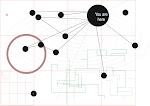Modernism picks up many of modernity’s philosophical trajectories as its guidance. Hazarding general definition of modernity we see an emphasis on the individual radically suspended in a dualistic and progressively rational, industrialized, urbanized and anti-historical society. Combining these factors with a profound sense of optimism in this new age of self-awareness, coupled with social upheaval produced a strange cocktail of utopian aspirations and existential despair. Cued by modernity, modernism cast off the perceived constraints of tradition, allowing solitary individuals and loosely connected tribes of like-minded others to pursue their personal visions, thus creating a staggering growth of artistic veins and ventures of innovation.
[1] This perpetual evolution or revolution of creative discovery becomes one of the traditional (though now often contested)
[2] hallmarks of modernism.
[3] For Clement Greenberg the essence of modernity, high art and summation for the artistic task meant a pervasive self-criticism or methodological doubt in order to eliminate that which might be borrowed from another media or previous form.
[4] This in turn would secure an authentic or purity of artistic expression, its value and survival. This meant, according to Greenberg, that painting pursue that which belongs primarily to it alone: color, shape and most integrally the two-dimensionality of the surface.
Surface transformation in painting has been at the center of modernism’s developments. The painting surface which once functioned like a transparent window transporting the viewer beyond the image or surface itself
[5] in modernism now impedes vision at the surface. It is not a rejection of space but a redefinition of it that is coupled with a progressive simplification and abstraction. Greenberg felt that traditional painting had sought an illusionary three-dimensional space whereas modernist painting reversed this impetus drawing an increased awareness and attention to the canvas surface.
[6] The Renaissance tradition of scientific or linear perspective masterly imaged in Raphael’s School of Athens (1510-1511) is radically altered and essentially reversed through a series of artistic evolutions.
This tradition’s early beginnings can be seen in Manet’s Dejeuner sur l’herbe (1863) by altering the scale of the rear bather combined with the shallow modeling the pictoral begins its continued collapse in modernity.
[7] Just over a decade later, Monet’s radically tilted landscaped plain Boulevard des Capucines, Paris (1873) brings the depth closer to the surface. Seurat, while maintaining an illusionary depth of space, utilized pointillism to heighten the importance of the surface. Matisse’s work Open Window, Collioure utilized large and complimentary colors next to each other to reverse “the Renaissance notion of the picture as a window…canceling the illusion of deep space.”
[8] The Fauves influence of large unmodeled color fields would remain a key component of Matisse’s work as obviously evident in Dance (1910) and The Red Studio (1911).
Braque and Picasso’s cubism draws upon Cezanne’s flat planes inventions thus abstracting their subject and reducing optical penetration to scans of the surface. Within synthetic cubism, both masters heightened interest in the surface by creating collage and papier colle respectively. Cubism attempted to balance “abstraction and illusion,” three-dimensionality condensed into a flat two dimensional surface.
[9] This continued evolution toward abstraction only heightened the importance of the image surface, replacing the significance of content for form of expression and experience. The holistic pouring method of Pollock, the flat color-fields of Newman and Rothko, as well as Reinhardt and Motherwell all brought a pure non-objectivity to coalesce with the surface. For Greenberg, this was the conceptual heart of modernism which was best evidenced in innovations and skepticism of the Abstract Expressionists and their successors who had progressively purged superfluous conventions to arrive at an autonomous and non-figurative art.
[10] Thus through the progression of modernism, the optical illusion of looking through the image gave way to a progressively flattened
[11] image where optics and surface converge in aesthetic experience.
[1] There is a strong irony within Modernism where it becomes a tradition of no tradition where old traditions were cast off in favor of newly created ones. This seems to suggest the reactionary cycle of the avant-garde.
[2] Pam Meecham and Julie Sheldon, Modern Art: A Critical Introduction (New York: Routledge, 2005), 31.
[3] According to Meecham, originality in modern theory is necessarily conjoined with authenticity and Greenberg’s sense of autonomy (Meecham, 13).
[4] Clement Greenberg, “Modernist Painting.” In Modern Art and Modernism: A Critical Anthology, ed. Francis Frascina and Charles Harrison, (New York: Harper & Row, Publishers, 1982), 5.
[5] Sam Hunter, John Jacobus, and Daniel Wheeler, Modern Art: Painting, Sculpture, Architecture, Photography (New York: Pearson Prentice Hall, 2005), 10.
[6] Gail Day and Chris Riding, “The Critical Terrain of ‘High Modernism’” in Varieties of Modernism, ed. Paul Wood, (New Haven: Yale University Press, 2004), 193.
[7] Hunter, 16.
[8] Hunter, 105.
[9] Hunter, 148.
[10] Gaiger, XX-XXI.
[11] Greenberg notes that Modernist painting cannot ever be entirely flat because from the first mark made on the canvas destroys its virtual flatness. Clement Greenberg, “Modernist Painting.” In Modern Art and Modernism: A Critical Anthology, ed. Francis Frascina and Charles Harrison, (New York: Harper & Row, Publishers, 1982), 8.
 (Grain Elevators, 1977 - Frank Gohlke)
(Grain Elevators, 1977 - Frank Gohlke)































